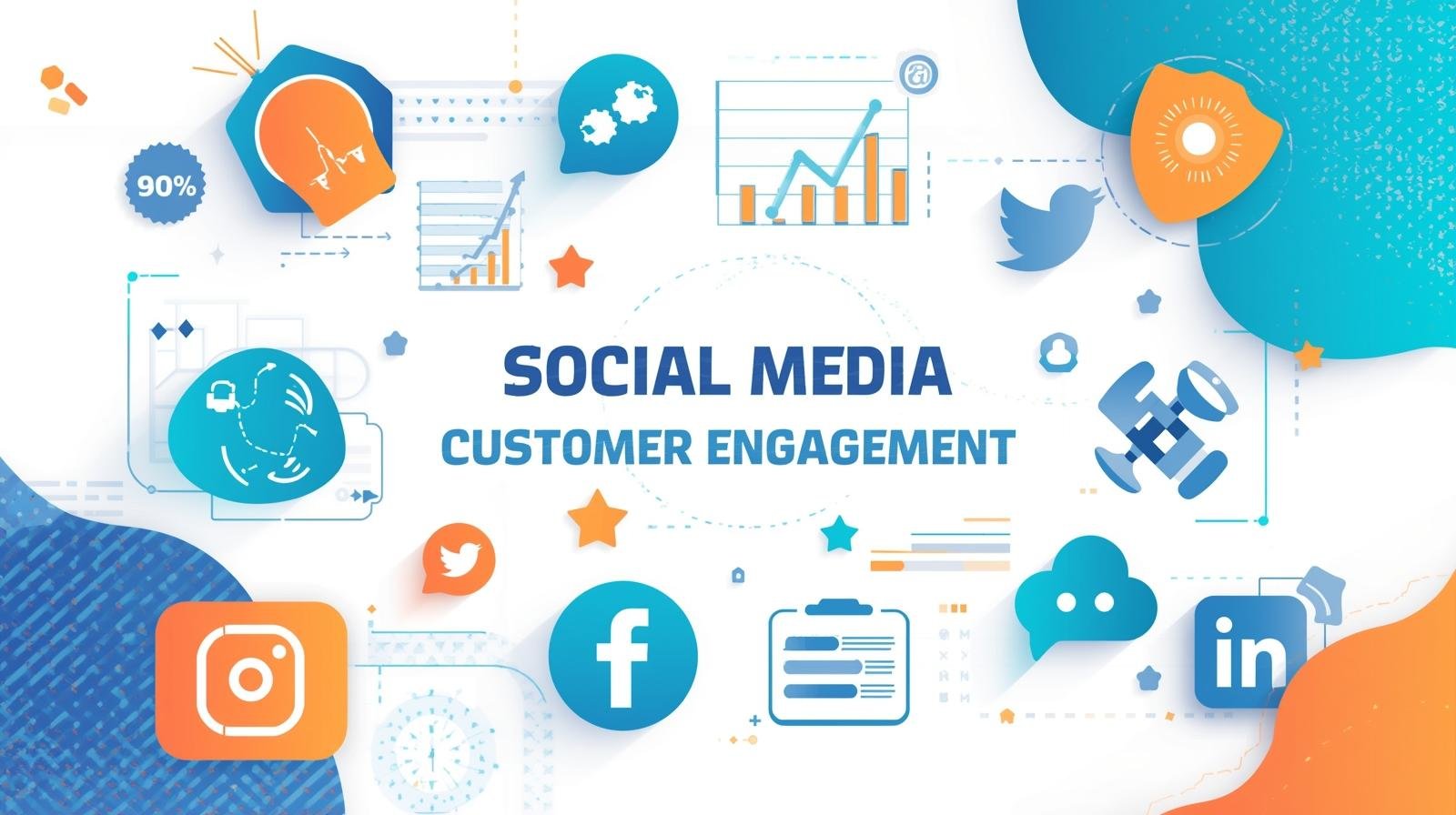In the digital age, where scrolling has become second nature, customer engagement on social media has evolved into one of the most important factors that define a brand’s success. It’s no longer enough to simply have a social media presence; what truly matters is how well you interact, respond, and connect with your customers.
Think of your social media page as a lively café rather than a static billboard. It’s a space where conversations happen, relationships grow, and loyalty is built one comment, one share, and one meaningful reply at a time.
Understanding Customer Engagement in Social Media
In simple terms, it’s the process of building and nurturing two-way communication between your brand and your audience through platforms like Instagram, Facebook, LinkedIn, X (Twitter), or TikTok.
It’s not about the number of followers you have or how many posts you publish per week. It’s about creating authentic interactions — the kind that make people stop, think, comment, share, and remember your brand.
For example, when a customer comments on your post, and you reply thoughtfully — not with a generic emoji, but with a genuine response — that small gesture strengthens trust. Over time, such interactions shape the customer’s perception of your brand.
Social media and customer engagement are inseparable today. While traditional marketing was one-way communication — brands talking to customers — social media flipped that model. Now, customers talk back. They share opinions, reviews, complaints, and even content about your brand.
Why Engaging Customers on Social Media Truly Matters
Let’s be honest — no one wakes up excited to see ads in their feed. People open social media to connect, learn, and be entertained, not to be sold to. That’s why the most successful brands today don’t interrupt conversations — they join them naturally.
Building engagement on social media isn’t just about likes and comments; it’s about creating meaningful connections that turn audiences into loyal customers. Here’s why engagement is a game-changer for your brand.
1. Builds Trust and Credibility
When people see your brand actively participating in real conversations — replying to comments, sharing valuable insights, and showing genuine personality — they begin to trust your brand.
Engagement humanizes your business. Instead of looking like a faceless company, you appear approachable, authentic, and relatable — and that’s what makes people want to do business with you.
2. Strengthens Loyalty and Retention
Consistent engagement keeps your audience connected to your brand. When customers interact with your posts or messages regularly, they start to feel part of your community.
This emotional connection builds long-term loyalty. Engaged followers are not just repeat buyers — they often become brand advocates, spreading positive word-of-mouth both online and offline.
3. Drives Organic Visibility
Engagement is the heartbeat of organic growth on social platforms. Every like, comment, or share signals to the algorithm that your content is worth promoting.
The more people interact with your posts, the more visibility you gain — without paying extra for ads. In simple terms: engagement drives reach, and reach fuels growth.
4. Improves Customer Experience
Customers expect quick, helpful responses on social media. When your brand listens, responds, and resolves issues in real time, it shows that you care about their experience.
That timely interaction builds emotional satisfaction — and satisfied customers are far more likely to return, recommend, and remain loyal to your brand.
5. Provides Real-Time Insights
Every comment, reaction, or review is more than just engagement — it’s valuable feedback.
Social interactions reveal what your audience loves, dislikes, and expects next. By analyzing these signals, you can adapt your strategy, improve products, and stay ahead of customer needs without guesswork.
The Psychology Behind Engagement
People engage when they feel seen, heard, and valued. It’s basic human psychology — we crave acknowledgment.
When brands create opportunities for conversation instead of just promotion, they tap into this natural desire for connection.
Think about how people react to posts that say,
“Tell us your favorite travel memory!” versus “Book your next trip now!”
The first invites participation. The second demands action.
Only one truly sparks engagement.
How to Engage Customers on Social Media: Proven Strategies
Now that we understand the “why,” let’s explore the “how.” Here are several human-tested, research-backed ways to boost engagement and make your social presence come alive.
1. Start Conversations, Don’t Just Post
The best way to engage customers on social media is by starting conversations. Ask questions, create polls, or encourage followers to share their experiences.
For instance, instead of posting a product photo with a caption like “Our latest design,” try saying, “Which of these two designs would you love to see on your desk?”
People love to express opinions. When you invite them in,You don’t need to post ten times a day. What matters is consistency and tone. Keep your brand voice human — warm, conversational, and approachable.
Avoid sounding robotic or overly corporate. If a customer cracks a joke, laugh with them. If someone complains, acknowledge them genuinely instead of hiding behind templated replies. they respond.
2. Be Consistent but Human
You don’t need to post ten times a day. What matters is consistency and tone. Keep your brand voice human — warm, conversational, and approachable.
Avoid sounding robotic or overly corporate. If a customer cracks a joke, laugh with them. If someone complains, acknowledge them genuinely instead of hiding behind templated replies.
3. Respond Quickly and Personally
One of the simplest yet most powerful ways to improve social media customer engagement is to respond fast. Speed shows that you care. A customer who gets a reply in minutes feels valued. Add a touch of personalization — use their name, reference their concern, or include a kind emoji.
A small brand once turned a frustrated tweet into a success story simply by responding within five minutes. The customer’s next post? “Best service ever!”
4. Encourage User-Generated Content (UGC)
Your customers are your best marketers. Encourage them to post about your brand and tag you.
You can run campaigns like “Share your favorite moment with our product” or feature customer photos on your main feed. When people see others being appreciated, they want to participate too.
UGC builds authenticity — something paid ads can rarely replicate.
5. Go Live and Be Real
Live sessions, Q&As, and behind-the-scenes videos create instant connection. They show that there are real humans behind the brand name.
You could host a “behind-the-scenes” livestream, a short product demo, or even an informal chat with your founder.
These moments of transparency build trust and drive deep engagement.
6. Share Stories That Resonate
Humans think in stories. So instead of listing features or data, tell stories that stir emotions.
For example:
- How your brand started.
- A customer’s success story.
- Challenges your team overcame.
7. Use Contests and Giveaways Smartly
Everyone loves winning something — even if it’s small. Hosting interactive contests such as “Caption this photo!” or “Tag a friend who would love this” can skyrocket engagement.
But make sure your prizes are relevant to your brand. The goal isn’t just engagement numbers; it’s community building.
How to Engage Your Customers on Different Platforms

Instagram and Facebook
Use interactive stories, polls, reels, and live videos to keep your audience engaged. Maintain a casual, friendly, and visually appealing tone that feels authentic and personal. Highlight user-generated content regularly to build community trust and encourage participation.
Position yourself as a thought leader by sharing industry insights, professional experiences, and meaningful lessons. Craft posts that spark discussion through open-ended questions or fresh perspectives. Keep your tone informative, confident, and value-driven to attract professionals and decision-makers.
X (Twitter)
Adopt a conversational and quick-witted voice. Participate in trending topics, share real-time updates, and respond actively to comments and mentions. Use polls and short threads to encourage engagement and maintain a consistent, approachable brand presence.
TikTok
Be authentic, creative, and energetic. Leverage trending sounds, challenges, and storytelling formats to connect with a younger, fast-moving audience. Keep videos short, visually dynamic, and relatable to encourage shares and participation.
YouTube
Focus on educational, informative, or storytelling-style videos that offer real value. Use pinned comments, community posts, and polls to engage viewers beyond the video itself. Maintain a friendly yet authoritative tone and encourage viewers to like, comment, and subscribe for continued interaction.
Common Mistakes That Kill Engagement
Even good brands sometimes struggle. Here are mistakes to avoid:
- Posting without interacting.
- Responding late or not at all.
- Sounding overly promotional.
- Ignoring feedback or criticism.
- Using automation excessively.
- Posting inconsistently.
The Future of Customer Engagement in Social Media
The landscape is changing fast. Artificial intelligence, personalized content, and real-time interactions are reshaping how brands engage.
AI tools can now analyze conversations, suggest replies, and predict customer needs — but the human touch remains irreplaceable.
Future engagement will likely revolve around community-driven content. Brands will build micro-communities — private groups, niche forums, and exclusive memberships — where loyal fans gather.
At the same time, authenticity will matter more than polish. Customers prefer seeing unfiltered, human content over glossy ads.
Conclusion
In today’s fast-moving digital world, social media and customer engagement go hand in hand. It’s no longer enough for brands to simply exist online — they must actively participate, listen, and care about their audience.
When brands show up consistently, communicate like real people, and genuinely celebrate their customers, they don’t just gain followers — they build lasting communities.
Whether you’re a startup or an established global brand, the best time to start is now.
Ask meaningful questions, share authentic stories, reply to comments, and express gratitude.
That’s the secret to true social media engagement — not by shouting louder, but by listening better and connecting deeper.
Frequently Asked Questions (FAQs)
Q1. What does customer engagement in social media mean?
Customer engagement on social media refers to how your brand interacts with its audience through comments, likes, shares, direct messages, and other forms of two-way communication.
It’s all about building trust, relationships, and emotional connection with your followers rather than just promoting your products.
Q2. Why is social media engagement important for businesses?
Engagement is the heartbeat of social media success.
It helps strengthen brand loyalty, increase visibility, and convert casual followers into long-term customers. When users feel seen and heard, they’re more likely to advocate for your brand — leading to organic growth and a stronger community presence.
Q3. How can I increase customer engagement on social media?
To boost engagement, focus on consistency and authenticity.
Post interactive content like polls, quizzes, and stories, and respond to comments quickly.
Encourage user-generated content and make your audience feel valued by acknowledging their contributions.
Q4. What’s the best type of content for engagement?
The most engaging content is authentic, visual, and emotionally driven.
Use a mix of reels, behind-the-scenes clips, storytelling posts, polls, and customer highlights.
Visual storytelling captures attention quickly and keeps your audience emotionally connected to your brand.
Q5. How often should I post on social media?
Quality over quantity always wins.
Aim to post 3–5 times per week while staying active daily in comments, stories, and DMs.
Consistency helps your audience know when to expect content, which improves visibility and strengthens brand recall.
Q6. Can small businesses benefit from engagement strategies?
Absolutely — and sometimes even more than big brands.
Small businesses can be more personal, authentic, and responsive, giving them a unique edge.
By showing genuine care and connecting directly with customers, small brands can build a loyal and passionate community faster.
Q7. What are signs of good engagement on social media?
Look for meaningful comments, saves, mentions, shares, and real conversations happening around your posts. When people engage because they care — not just scroll — that’s when your social media strategy is truly working.





Comments are closed